Three Strikes And You're Out
Looking back at the chopper that came a-cropper, Desert Strike.
Explosions. Hostages. Despair. Confusion. Blood. Lots of sand. Just another quiet day in Iraq? Well, yes...err, but the last time, not the current one. Except not quite the last time either, because the makers of 1992's Desert Strike were curiously cagey about using specific names - whilst at the same time making it extremely obvious what they were on about.
I'm sure we all remember the first Gulf War [you weren't there, man - Ed]. Admittedly, my recollections focus on the annoyance of discovering the news had overrun again and shunted a Pink Panther cartoon from the schedules. But still, the memories are there. Anyway, it's easy to undertake a refresher course by giving Desert Strike another whirl.
Whirly Bird
A hugely distorted refresher course, that is.
Realising that political nuance tends to play less successfully with the gaming public than flashy boom-booms and fetishistic worship of military hardware, Mike Posehn and chums opted for an exciting pretend-o-3D helicopter title. Consequently, the "madman" in charge of the unnamed, aggressive Middle Eastern nation that definitely isn't Iraq is a delicate shade of pure evil (not entirely unfair, as he does look strangely like a young Gary Bushell hiding behind a pair of John Lennon shades). He has no motives in particular, other than destroying the entire world - despite most theoretical and historical evidence pointing to the idea that small-state dictators tend to favour actions that protect their own regime. There's no mention of any Western powers backing Bushell during his country's equivalent Iraq-Iran war, let's put it that way.

Still, the one-note plot isn't really the point, unless you see it as a further attempt to cement a simplistic good-vs-evil Gulf War narrative with the general public. Which might be a touch paranoid, really. Whatever the case, Desert Strike was a massive success - appearing across pretty much every platform of the age (plus the Game Boy Advance a decade later) and spawning a host of Strike-suffixed sequels. It's the Mega Drive (or Genesis for those of you peaking in from America) version, however, which generally wins a scuffle for the 'definitive' crown. Not least because computer-based conversions tested players patience with loading screens, disk changes and control configurations which stopped just short of demanding a little magical dance before weapons could be cycled.
Nice Warm Ba'ath
Cashing-in on the first war to be presented as a Tomorrow's World military-hardware special (smart bombs! scud missiles! night vision!), Desert Strike sensibly placed the protagonist and moderately-trusty wingman inside an AH-64 Apache. As well as being one step closer to a rotor-head's wet dream, the precision hovering available in a chopper added a certain tactical dimension. Rather than frantically whizzing about all the time, an unusual stop-start pace could be instilled; one where maps are studied and accurately followed, hostages or supplies winched aboard and specific mission objectives scouted and targeted in the most strategically advantageous way. These objectives also tended to be in-keeping with the Gulf War's default presentation through the '90s news studios - a war of distant attacks against installations and buildings (radars, airstrips and the like), with few mentions of any 'soft targets' inside and further dehumanised by the increased spread of subtle jargon. Friendly Fire always sounded so much sweeter than the reality, didn't it?
In other areas, Desert Strike settled for well-worn gaming oddities - such as placing sole trust in a single helicopter team to avert nuclear war and then slightly spoiling the element of surprise by, um, loudly announcing the plan over the 'EANN News' network. Fine work was done, however, in making large expanses of desert look relatively interesting, with all manner of dusty roads, nomad outposts and trundling hulks of anti-helicopter death contributing to the sandy theme. Of course there were also the obligatory oil wells, which, tempting though they were to blow up, it was in the national interest to protect. Surprisingly.

Trigger-happy pilots had to settle for using a selection of exploding sticks on military bases, chemical weapons plants and the odd wildcard soldier with a rocket launcher. This not only tended to be useful for survival, but also produced a selection of meaty technicolour fireworks to marvel at. Oooh. Ahhh. Combined with the open-ended, exploratory approach, whereby secondary and tertiary missions could be attempted on the map at will, and some neat touches like winching stranded soldiers to safety, a fine time was generally had by all who played.
Naturally, there were also problems. Bumbling into bits of the scenery due to confusions over the perspective was quite a regular one. As was the annoying tendency to accidentally destroy a much-needed ammo dump or vital hostage inside a building by firing off a couple of shots too many. The game also seemed to overly reward caution, with the safest way to complete most objectives simply being to nudge the nose of the chopper forward until a defensive unit had been identified and destroyed, then repeating the process until the main target was totally vulnerable. Unfortunately, this was also the dullest method of play.







